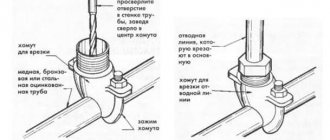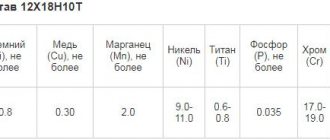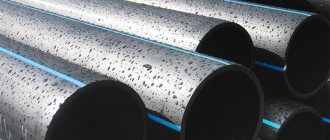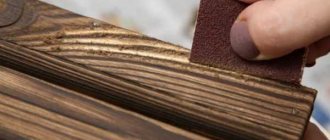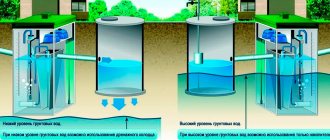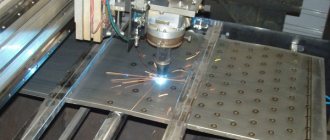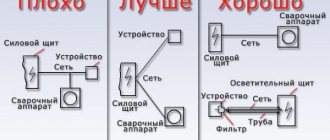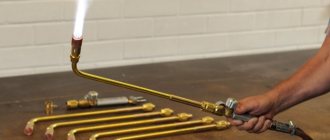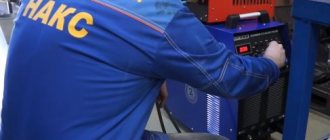Argon-arc welding received this name because of the specifics of its action: an arc discharge occurs in an inert gas-argon environment, which leads to the formation of a melting pool and the connection of metal surfaces with each other. Electrodes for argon arc welding can be of two types.
Welding surfaces using this method can be carried out using a melt electrode or a tungsten electrode, which remains intact and melts the edges being joined.
In the technical nomenclature, argon arc welding machines are designated by the following abbreviations:
- RAD – manual argon arc welding using a tungsten electrode;
- AMA - argon welding in automatic mode, when the gas torch is supplied to the welded edges automatically using a special support;
- AADP - the additional “P” means that this device uses consumable electrodes.
The international standard uses the following abbreviations, usually in devices with non-consumable electrodes:
- TIG – welding is performed using tungsten in an inert environment;
- GTAW – gas tungsten welding.
Independent, without the participation of professionals, but high-quality and fast assembly of metal structures during repair work, soldering of seams, as well as cutting of various metal products is possible with the help of a good welding machine for the home. How to choose an easy-to-use welding machine for your home?
Among the many metal processing technologies, laser cutting stands out for its cost-effectiveness and efficiency. Read more about laser cutting of metal here.
Technical characteristics of argon arc welding
Argon is used primarily to displace air from the welding environment and reduce to zero the interaction of the molten edges with air, the ingress of which can lead to treachery.
Initially, this technique was used for welding aluminum surfaces (argon arc welding of aluminum). All welding is done using droplets of molten metal (large droplet and drip).
Features of arc ignition
The start of ignition with stable combustion maintenance is facilitated with a constant current of straight polarity . High-density currents with minimal amperage do not contribute to overheating and failure of the electrode.
Changing the polarity is fraught with an increase in arc voltage. The electrode loses its heat resistance, and the arc itself loses its stability. The positive aspect of reverse polarity is that the bombardment of argon particles with positive charges destroys the oxidation of the welded surface.
The flow of electrons causes the electrified gas to become a conductive plasma . For aluminum welding, this aspect is important. The low melting point and fluidity are overcome by lower currents than when welding steel.
Welding copper is complicated by the need for heating, the addition of deoxidizing additives, and fluxes for critical connections . With a non-consumable electrode, straight polarity is used.
Small diameter wire with deoxidizers is fed semi-automatically at high speed. Productive mode with a stable arc and proper penetration is ensured by reverse polarity.
As the feed speed increases, the melting of the wire changes from fine-droplet melting to jet melting. The seam density is satisfactory, spattering is minimal.
Scope of argon arc welding
The most basic area of application is the joining of non-ferrous metals and alloy steels, especially of low thickness. Otherwise, additives are used.
Additives for argon-arc welding are metals of higher density and lower melting point, which are sprayed by surfacing and act as a connecting “layer”.
In this case, welding is only possible in an environment of inert gases or carbon dioxide, since the entry of air will lead to spattering of soft molten metals.
Popular welding methods in Poland - list
Numerical symbols for welding methods PN-EN ISO 4063:2002 Welding and related processes. Process names and numbers.
- 111 Spawanie łukowe elektrodą otuloną MMA (covered electrode arc welding MMA)
- 113 Spawanie łukowe elektrodą nieotuloną (arc welding with an uncovered electrode)
- 114 Spawanie łukowe samoosłonowym drutem proszkowym (arc welding with powder coating)
- 121 Spawanie łukiem krytym drutem elektrodowym (arc welding with electrode wire)
- 131 Spawanie metodą MIG (MIG welding)
- 135 Spawanie metodą MAG (welding using the MAG method)
- 136 Spawanie w osłonie gazu aktywnego drutem proszkowym (shielded gas welding with active flux-cored wire)
- 137 Spawanie w osłonie gazu aktywnego drutem proszkowym (shielded gas welding with active flux-cored wire)
- 141 Spawanie metodą TIG (TIG welding)
- 151 Spawanie plazmowe (plasma welding)
- 311 Spawanie acetylenowo-tlenowe (oxygen-acetylene welding)
- 912 Lutowanie twarde płomieniowe (hard flame soldering)
- MIG/MAG method (semi-automatic welding).
Less known and less popular methods can be found here.
Tig welding technology
In general, technological standards can be divided into two types:
- manual mode, when a torch with a tungsten electrode and a filler rod are manually fed by a specialist to the place of connection and surfacing;
- automatic mode, when everything is served automatically. Argon arc welding of pipes is the clearest example, since when connecting pipelines, the seam must meet the requirements for standard sizes. Installation of argon arc welding in this case is carried out on special frames-spars, which provide movement relative to their plane and axis.
A weld seam is usually called a permanent connection, which is formed during the process of solidification of the weld pool from the melting of metal edges with an electrode. Read more about welding seams.
Extremely similar to argon, plasma welding occurs using a plasma arc flow. More details here.
An argon burner contains a hard tungsten electrode, to which a high-frequency current is supplied from an oscillator. This current ignites the “jet”.
welding equipment
The production of welds is carried out using automatic and semi-automatic devices.
The automatic device includes:
- gas reducer;
- acid cylinder;
- heater;
- dehumidifier.
The main element of the machine is the welding head. The speed of melting depends on the speed at which it feeds the electrode wire (constant or variable).
Approximate cost of automatic devices on Yandex.market
The semi-automatic machine provides wire feeding mechanically. The movement of the arc in the direction of the seam is carried out manually.
Semi-automatic equipment includes:
- electric holder;
- cassette;
- control cabinet;
- welding torch;
- power supply;
- the wire.
Approximate cost of machines for semi-automatic welding on Yandex.market
The main element of the mechanism is the electric holder.
It keeps the electrode in a certain position and provides current to the welding area. The arc is activated by a short circuit or a trigger button located on the handle of the holder.
Advantages and disadvantages of argon arc welding
Pros:
- reliable isolation from the environment, improved quality and no disruption of the crystal lattice in the connected surface;
- indicative thermal power of the arc discharge, which has a positive effect on the quality and speed of welding;
- argon arc welding allows you to join dissimilar metals;
- the entire process can be carried out under supervision.
Minuses:
- protection by argon from ambient air can be impaired when working in wind or draft, since the gas can simply “blow away”;
- the torch must be periodically cooled when welding with a high-current arc;
- strong ultraviolet radiation, especially when using helium as an inert gas.
Since hot and welding work requires special skills from the work manufacturer, compliance with technical and industrial safety standards, as well as approvals, periodic certification is carried out in order to extend or obtain permission and admission to hot work of various categories.
Information about the welding pencil can be found here.
Modes
Reference tables will tell you how to cook with argon for a beginner when welding at home . The completeness of the data will help you determine the basic settings in advance and adjust the modes.
It remains to ensure that the torch is at an angle of more than 800 relative to the workpiece, the tip of the electrode protrudes from the nozzle by 3–5 mm, and hold it 2–3 mm above the workpiece when the arc is excited.
The current load is determined:
- electrode (wire) diameter;
- metal types and thicknesses;
- polarity.
Ferrous metal is welded with argon with straight polarity . Gas is supplied in a uniform flow without pulsation.
Decoding the concepts of NAKS
Every welding specialist should know that NAKS is the National Welding Control Agency. It is this institution in the Russian Federation that deals with certification issues:
- welders
- welding equipment, technologies and materials
- enterprises
The certification procedure itself is optional for specialists hoping to confirm their professional level and is mandatory for newcomers or categories of employees who violate technological regulations. Materials and equipment require certification provided they are used in critical areas of mining, boiler or metallurgical equipment. The requirements for certification of enterprises are unique and are necessary in the case of introducing new technologies or participating in large projects.
Improving skills and increasing professional level through certification are necessary to work with dangerous technical devices. They are divided into groups:
- NAKS KO - boiler equipment. Vessels, steam boilers, pipelines operating at temperatures from 115 0C, under pressure conditions >0.07 MPa, as well as safety devices, structures and devices for boiler equipment.
- NAKS KSM - steel structures of supports, buildings, bridges in factory conditions, as well as welding during repair and installation.
- NAKS NGDO - oil and gas production equipment, pipelines and main oil product pipelines for transporting oil during repairs, condensate pipelines, main gas pipelines, tanks for oil and oil products, gas tanks, pipelines and shut-off valves, their parts used in the factory, pumps, compressors and drilling equipment for production and oil refining.
- NAKS OKHNVP - cryogenic equipment, equipment for petrochemical production, compressors and pumps, boilers, centrifuges, cylinders under pressure up to and above 16 MPa.
- NAKS MO - metallurgical equipment. Pipelines, machines and technical devices for non-ferrous and ferrous metallurgy. Furnaces, steelmaking equipment and mills.
- NAKS SK - building structures. There are three groups of technical devices: SK1 - metal structures; SK1 - fittings; SK 3 - metal pipelines; In addition, SCs include pipelines and structures made of polymers.
- NAKS GO - Gas equipment. Gas pipelines and pipelines of low and high pressure, gas boiler equipment. Furnaces and water heaters
- NAKS PTO - Lifting and transport equipment. Cranes and transport equipment and devices. Hoists, elevator platforms, lifts, hoist chains, mechanisms and parts.
There are a huge number of welding (surfacing) methods. When taking the exam, you need to know the definition of the main types of welding:
- RD - Manual arc welding with coated electrodes.
- RDV - Bath arc welding with coated electrodes.
- RAD - Manual argon arc welding with a non-consumable electrode.
- MP - Mechanized welding with consumable electrode in active gases and gas mixtures.
- EL - Electron beam welding.
- APG - Automatic welding with consumable electrode in active gases and gas mixtures.
- MF - Mechanized submerged arc welding.
- PAK - Soldering.
- P - Plasma welding.
- AMA - Automatic argon arc welding with a non-consumable electrode.
- AF - Automatic submerged arc welding.
- ES - Electroslag welding.
- AADP - Automatic argon arc welding with a consumable electrode.
